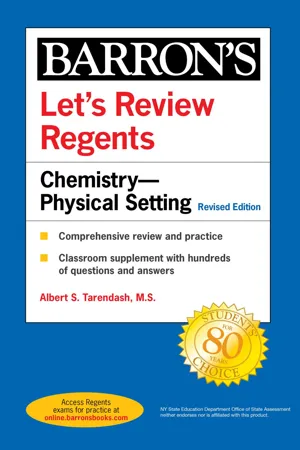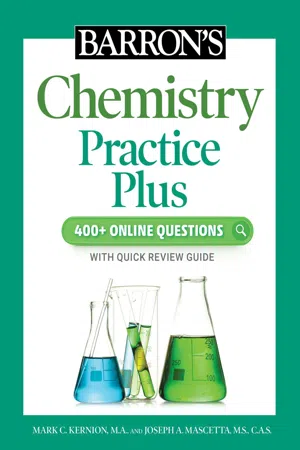Chemistry
Periodic Table
The Periodic Table is a tabular arrangement of chemical elements, organized by their atomic number, electron configuration, and recurring chemical properties. It provides a systematic way to understand the relationships between elements and predict their behavior. The table is divided into periods (rows) and groups (columns) based on shared characteristics, making it a fundamental tool for understanding the properties of elements.
Written by Perlego with AI-assistance
Related key terms
Related key terms
1 of 4
Related key terms
1 of 3
10 Key excerpts on "Periodic Table"
- Christopher R. Hren, John T. Moore, Peter J. Mikulecky(Authors)
- 2022(Publication Date)
- For Dummies(Publisher)
Periodic Table of the elements! But don’t be fooled by its stern appearance or intimidated by its teeming details. The table is your friend, your guide, your key to making sense of chemistry. To begin to make friends with the table, concentrate on its trends. Start simply: Notice that the table has rows and columns. Keep your eye on the columns and rows, and soon you’ll be making sense of things like atomic radii and valence electrons. Really.Organizing the Periodic Table
In nature as well as in manmade systems, you may notice some repeating patterns. The seasons repeat their pattern of fall, winter, spring, and summer. The tides repeat their pattern of rising and falling. Tuesday follows Monday, December follows November, and so on. This pattern of repeating order is called periodicity.In the mid-1800s, Dmitri Mendeleev, a Russian chemist, noticed a repeating pattern of chemical properties in the elements that were known at the time. Mendeleev arranged the elements in order of increasing atomic mass (see Chapter 3 for a description of atomic mass) to form something that fairly closely resembles the modern Periodic Table. He was even able to predict the properties of some of then-unknown elements. Later, the elements were rearranged in order of increasing atomic number, the number of protons in the nucleus of the atom (again, see Chapter 3 ). Figure 5-1 shows the modern Periodic Table.FIGURE 5-1: The Periodic Table of the elements.Examining the organization of the Periodic Table
Chemists can’t imagine doing much of anything without having access to the Periodic Table. Instead of mastering the properties of 118+ elements (more are created almost every year), chemists — and chemistry students — can simply get a firm grasp of the properties of families of elements, thus saving a lot of time and effort. You can find the relationships among elements and figure out the formulas of many different compounds by referring to the Periodic Table. The table readily provides atomic numbers, mass numbers, and information about the number of valence electrons (the outermost s and p electrons; see Chapter 6- eBook - ePub
- Jeffrey Gaffney, Nancy Marley(Authors)
- 2017(Publication Date)
- Elsevier(Publisher)
An understanding of this periodicity of the chemical properties of the elements allowed chemists to predict how elements would combine and how they would behave when reacting with other elements. The development of the Periodic Table of the Elements can thus be compared to the discovery of the “Rosetta Stone,” which provided the key to the translation of ancient languages into modern text and for the first time allowed scholars to be able to understand the meaning of ancient documents. Similarly, the Periodic Table effectively organizes the elements into classes according to their electronic configurations, providing the key to understanding and predicting the chemical behavior of the elements. In order to effectively use the Periodic Table to predict chemical properties and behavior of the elements, it is important to first know how its structure relates to electronic configurations.The general layout of the modern Periodic Table is shown in Fig. 1.12 . It arranges the elements in vertical columns called groups. There are 18 groups in the Periodic Table numbered 1–18. Elements in the same group generally share the same chemical properties with clear trends associated with increasing atomic number going down a group. Some groups are known by family names to indicate the similar properties that they share. Group 1 is called the alkali metals (lithium, sodium, potassium, rubidium, cesium, and francium). Group 2 is known as the alkaline earth metals (beryllium, magnesium, calcium, strontium, barium, and radium). Group 17 is the halogens (fluorine, chlorine, bromine, iodine, and astatine) and group 18 is the noble gases (helium, neon, argon, krypton, xenon, and radon). Elements in groups 3–12 are known collectively as the transition metals.The elements are also arranged in seven horizontal rows called periods because the periodic properties of the elements increase systematically with increasing atomic number going across a row. There are seven periods in the Periodic Table numbered 1–7. The number of each period corresponds to the principal quantum number of the outermost electron shell containing electrons for all elements in the period. So, the elements in period 1 contain electrons only in the n = 1 shell, while the elements in period 2 contain electrons in the n = 1 and n = 2 shells, and elements in period 3 contain electrons in the n - eBook - ePub
Foundations for Teaching Chemistry
Chemical Knowledge for Teaching
- Keith S. Taber(Author)
- 2019(Publication Date)
- Routledge(Publisher)
Figure 9.1 ). Two students sitting opposite each other, and referring to the same representation of the Periodic Table flat on the table between them, should agree that nitrogen is found ‘above’ phosphorus. There is then a general shared graphical literacy that applies here (just as the students would agree who was ‘top’ of a sports league or music chart from a standard representation), but it should be pointed out how we read the Periodic Table.Figure 9.1 We ‘read’ the Periodic Table in a conventional orientation, regardless of how a particular representation of the table is orientated to our viewpointWhat is the Periodic Table?It is useful for the teacher to reflect on the nature of the Periodic Table (i). The Periodic Table is a representation of the periodicity of elemental properties. It is a way of summarising a good deal of information, and so a thinking tool in building explanations and predictions. It is also, in an important sense, a model (see Chapter 3 ).The Periodic Table is a model because it simplifies the complexity of the nature of the chemical elements. It seeks to present patterns of similarity (and so of differences) between elements, but in doing so it has to make compromises because there is a vast amount of data available about the elements, and so actual patterns in elemental properties are very complex and could not be included in any simple, single geometric pattern. This is clearer if we consider the kind of concept that periodicity is. - eBook - ePub
Chemistry
The Molecular Nature of Matter
- Neil D. Jespersen, Alison Hyslop(Authors)
- 2018(Publication Date)
- Wiley(Publisher)
When the concept of atomic numbers was developed, it was soon realized that the elements in Mendeleev’s table were arranged in precisely the order of increasing atomic number. That it is the atomic number—the number of protons in the nucleus of an atom—that determines the order of elements in the table is very significant. We will see later that this has important implications with regard to the relationship between the number of electrons in an atom and the atom’s chemical properties.The modern Periodic Table is shown in Figure 2.1 and also appears on the inside front cover of the book. We will refer to the table frequently, so it is important for you to become familiar with it and the terminology applied to it.Periodic TableFigure 2.1 The modern Periodic Table. At room temperature, mercury and bromine are liquids. Eleven elements are gases, including the noble gases and the diatomic gases of hydrogen, oxygen, nitrogen, fluorine, and chlorine. The remaining elements are solids.Special Terminology of the Periodic Table
In the modern Periodic Table the elements are arranged in order of increasing atomic number. The horizontal rows in the table are called periods , and for identification purposes the periods are numbered. Below the main body of the table are two long rows of 14 elements each. These actually belong in the main body of the table following lanthanum( La: Z = 57 )and actinium( Ac: Z = 89 ), as shown in Figure 2.2 . They are almost always placed below the table simply to conserve space. If the fully spread-out table is printed on one page, the type is so small that it’s difficult to read. Notice also that in the fully extended form of the table, there is a great deal of empty space. An important requirement of a detailed atomic theory, which we will get to in Chapter 7 , is that it must explain not only the repetition of properties, but also why there is so much empty space in the table.- Recall that the symbol Z stands for the atomic number.
Figure 2.2 Extended form of the Periodic Table. The two long rows below the main body of the table in Figure 2.1 are placed in their proper places in the table.The vertical columns in the Periodic Table are called groups , also identified by numbers. However, there is not uniform agreement among chemists on the numbering system. In an attempt to standardize the table, the International Union of Pure and Applied Chemistry (IUPAC) officially adopted a system in which the groups are simply numbered sequentially, 1 through 18, from left to right using Arabic numerals. Chemists in North America favor the system where the longer groups are labeled 1A to 8A and the shorter groups are labeled 1B to 8B in the sequence depicted in Figure 2.1 . (In some texts, groups are identified with Roman numerals; Group 3A appears as Group IIIA, for example.) Note that Group 8B actually encompasses three short columns. The sequence of the B-group elements is unique and will make sense when we learn more about the structure of the atom in Chapter 7 - Albert S. Tarendash(Author)
- 2021(Publication Date)
- Barrons Educational Services(Publisher)
masses of the elements. This arrangement led to some problems, however, because the atomic masses of the elements do not increase regularly. Compare, for example, the atomic masses of tellurium (Te) and iodine (I).In the early twentieth century, physicist Henry Moseley (England) discovered what we now call our modern periodic law: The periodic properties of the elements are functions of their atomic numbers. This means that the Periodic Table should be arranged in order of increasing atomic number—which it is! However, the basis of the Periodic Table is the (ground-state) electron configuration of each element.Passage contains an image
9.3 THE MODERN Periodic Table
The modern Periodic Table is described in terms of periods (the horizontal rows) and groups (the vertical columns). Each period is indicated by a number, beginning with 1 and currently ending with 7. Elements in the same period have the same number of occupied principal energy levels. For example, the elements sodium (Na) and phosphorus (P) are in the same period—3. Therefore, sodium and phosphorus have three occupied principal energy levels. The period number of an element also tells us the valence level of the element: the valence level of sodium and of phosphorus is also 3.The groups begin at the left side of the table (Group 1) and continue through Group 18 on the right side. Elements within a group share similar properties, and this likeness is directly related to the similarities in the electron configurations of their valence levels. For this reason, we also call a group a chemical family. For example, the elements in Group 13 constitute a chemical family: Atoms of Group 13 elements each have three valence electrons. Consequently, the properties of the elements in this group are similar to one another. (We note, however, that the word similar does not- eBook - ePub
- Atef Korchef(Author)
- 2022(Publication Date)
- CRC Press(Publisher)
7 Periodic Table of Elements and Properties of Atoms
DOI: 10.1201/9781003257059-77.1 Objectives
At the end of the present chapter, the student will be able to:- Explain how elements are arranged in the Periodic Table of elements.
- Determine the position of an element in the Periodic Table.
- Recognize the different categories of elements in the Periodic Table of elements.
- Describe the properties of atoms and how these properties vary along a period or along a group in the Periodic Table of elements.
7.2 The Periodic Table of Elements
In the Periodic Table of elements, the elements are arranged in order of increasing atomic number (Z). The vertical columns of the table (numbered from 1 to 18) are called groups or families. Elements in the same group have similar but not identical characteristics.The horizontal rows of the table (numbered from 1 to 7) are called periods (Figure 7.1 ).FIGURE 7.1 The Periodic Table of elementsElements in the same group have the same number of valence electrons (same number of electrons in the outermost shell), and hence similar chemical properties. The valence electrons are the electrons that are transferred or shared when atoms bond together.- Examples:
- 1 H: 1s1
- 3 Li: [He] 2s1
- 11 Na: [Ne] 3s1
- 19 K: [Ar] 4s1
- 37 Rb: [Kr] 5s1
- 55 Cs: [Xe] 6s1
- 87 Fr: [Rn] 7s1
- Examples:
- 5 B: 1s2 2s2 2p1
- 6 C: 1s2 2s2 2p2
- 7 N: 1s2 2s2 2p3
- 8 O: 1s2 2s2 2p4
- 9 F: 1s2 2s2 2p5
- 10 Ne: 1s2 2s2 2p6
In the Periodic Table of elements, the elements can be arranged according to their electronic configuration. For example, the position of an element in the Periodic Table can be defined easily using its electronic configuration, and more specifically, using its valence shell and valence electrons. Indeed, the number of valence electrons indicates the group in which the element is situated, and the valence shell gives the period in which the element is situated (Figure 7.2 - eBook - ePub
- Léna Soler, Sjoerd Zwart, Michael Lynch, Vincent Israel-Jost, Léna Soler, Sjoerd Zwart, Michael Lynch, Vincent Israel-Jost(Authors)
- 2014(Publication Date)
- Routledge(Publisher)
The practices of late-19th-century chemistry established the discipline and significantly shaped the path of its development. Patterns of reasoning invoked then still thrive today, and the desire for control over a large, diverse set of facts has become only more pressing. A brief discussion of contemporary uses of the table will reveal the continuing productivity of the representation, something that could not be evident in its early days and yet is partially a consequence of the original entrenchment.II.2. The Periodic Table in Contemporary Context: Linking Representation to Explanation16
The Periodic Table is now the single most iconic representation in contemporary chemistry (see Figure 4.4 ). Its centrality to chemical education and practice is easily discerned from the table’s ubiquitous presence in classrooms, laboratories, and textbooks. But why exactly is it there? What role does it play? No doubt the Periodic Table is a primary tool for classification. Descriptive chemistry constitutes an enormous domain of inquiry, and the Periodic Table aims rather heroically to impose structure, and intelligibility, on this vast landscape.A well-known university chemistry textbook makes the point in this way:With the help of this periodic law, it is possible to organize and to systematize the chemistry of the elements into a manageable subject.Figure 4.4 A contemporary version of the Periodic Table of elementsLearning descriptive chemistry then becomes a process of discovery and assessment of facts, prediction and verification of chemical behavior, and evaluation of correlations and explanations. All of this leads to an understanding of why elements have the properties they do. (Mahan, 1975, p. 569, italics in original)This statement is telling because it suggests that the ultimate goal is not organization per se but rather what such organization facilitates. According to Mahan, the periodic law makes certain information manageable and, as a result, facilitates “discovery”, “assessment”, “prediction”, “verification”, and “evaluation”. And here is the punch line: “All of this leads to an understanding of why elements have the properties they do ” (emphasis added). In other words, the periodic law, by facilitating central aspects of inquiry, plays a significant role in explaining the properties of the elements.17 - eBook - ePub
Inorganic Chemistry
From Periodic Classification to Crystals
- Robert Valls(Author)
- 2017(Publication Date)
- Wiley-ISTE(Publisher)
1 Knowledge of the Periodic Table1.1. Presentation of the Periodic Table
The Periodic Table is one of the chemist’s everyday tools for retrieving the properties of an element based on its position in this table and the various values associated with it. However, before proceeding to use it, knowledge of several simple keys and of their limits should be acquired and their operation should be mastered.This table should not be perceived as a visionary anticipation or thought of as being received by a scientist through revelation. It is the result of lengthy and patient efforts sustained by Mendeleev and all the chemists in his time, drawing on the empirical knowledge accumulated throughout the 18th and 19th Centuries by several generations of chemists engaged in the pursuit of this classification, which was supposed to name and organize all the elements. Dozens of scientists should be cited, but in order to keep the presentation simple, only three of them will be mentioned here, namely those whose interventions were essential. The first one was Lavoisier, who in 1789 had formalized the notion of elements, then came Mendeleev, who is recognized as the creator of the Periodic Table according to his work published in 1869, and finally Moseley, who in 1913 offered the key to the complete form of the Periodic Table.The use of the table in the absence of several reading keys may prove discouraging, as it requires great memory and leaves the impression of a series of successive specific cases. Moreover, the method used by chemists in order to memorize the Periodic Table should differ from the one employed for multiplication tables (it is less mechancal), similar to that applied for memorizing the names, location and characteristics of places encountered every day and which are part of real-life experience, therefore involving every day and which are part of real-life experience, therefore involving - Mark Kernion, Joseph A. Mascetta(Authors)
- 2022(Publication Date)
- Barrons Educational Services(Publisher)
CHAPTER 2Atomic Structure and the Periodic Table of the Elements
Learning Objectives In this chapter, you will learn how to:Describe the history of the development of atomic theory.Explain the structure of atoms, their main energy levels, sublevels, orbital configuration, and the rules that govern how they are filled.Place atoms in groups and periods based on their atomic structure.Explain how chemical and physical properties are related to positions in the Periodic Table, including atomic size, ionic size, electronegativity, acid-forming properties, and base-forming properties.Explain the nature of radioactivity, the types and characteristics of each, and the inherent dangers.Identify the changes that occur in a decay series.The idea of small, invisible particles being the building blocks of matter can be traced back more than 2,000 years to the Greek philosophers Democritus and Leucippus. These particles, considered to be so small and indestructible that they could not be divided into smaller particles, were called atoms, which is related to the Greek word for indivisible. This early concept of atoms was not based upon experimental evidence but was simply a result of thinking and reasoning on the part of the philosophers. Not until the late eighteenth century did experimental evidence in favor of the atomic hypothesis begin to accumulate. This evidence helped formulate two fundamental chemical laws: the Law of Conservation of Matter and the Law of Definite Composition. Each of these hinted at the discreteness of matter. This specificity strongly suggested that matter was particulate. Finally, around 1805, John Dalton proposed some basic assumptions about atoms based on those laws and his own Law of Multiple Proportions. These assumptions are very closely related to what scientists presently know about atoms. The basic postulates of Dalton’s atomic theory- eBook - ePub
Understanding Basic Chemistry Through Problem Solving
The Learner's Approach
- Kim Seng Chan, Jeanne Tan(Authors)
- 2014(Publication Date)
- WSPC(Publisher)
CHAPTER 12 THE Periodic Table 1. (a) Explain what do you understand by the terms (i) atom, (ii) atomic number, (iii) relative atomic mass, (iv) empirical formula, and (v) molecular formula. Explanation: (i) An atom is the smallest building block of matter. It consists of electrons, protons, and neutrons. (ii) The atomic number indicates the number of protons present in an atom of an element. Different elements consist of atoms with different proton numbers. In a neutral atom, the atomic number is also equal to the number of electrons present. (iii) The relative atomic mass is the average mass of one atom of the element relative to 1/12 of the mass of a carbon-12 atom. The relative atomic number is a weighted average of the masses of the different types of isotopes that may be present for a particular element. (iv) The empirical formula (EF) of a compound is a representation of the simplest whole number ratio of the different atoms that made up the compound. (v) The molecular formula (MF) of a compound is a representation of the actual whole number ratio of the different atoms that made up the compound. Thus, MF = n × EF, i.e., an empirical formula is a fraction of the molecular formula. Q Why don’t we use the number of neutrons or number of electrons characterize an element? A: We have seen that an element can be made up of isotopes with the same number of protons but different number of neutrons. So, using the number of neutrons to characterize an element is not very good — which isotope would you prefer? How do you decide? Now, different species can have the same number of electrons but different number of protons or neutrons, so again, using the number of electrons to characterize an element cannot be as unique as using the number of protons to characterize it
Index pages curate the most relevant extracts from our library of academic textbooks. They’ve been created using an in-house natural language model (NLM), each adding context and meaning to key research topics.
Explore more topic indexes
Explore more topic indexes
1 of 6
Explore more topic indexes
1 of 4









